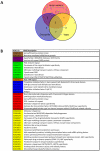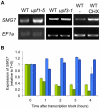A role for nonsense-mediated mRNA decay in plants: pathogen responses are induced in Arabidopsis thaliana NMD mutants
- PMID: 22384098
- PMCID: PMC3284524
- DOI: 10.1371/journal.pone.0031917
A role for nonsense-mediated mRNA decay in plants: pathogen responses are induced in Arabidopsis thaliana NMD mutants
Abstract
Nonsense-mediated mRNA decay (NMD) is a conserved mechanism that targets aberrant mRNAs for destruction. NMD has also been found to regulate the expression of large numbers of genes in diverse organisms, although the biological role for this is unclear and few evolutionarily conserved targets have been identified. Expression analyses of three Arabidopsis thaliana lines deficient in NMD reveal that the vast majority of NMD-targeted transcripts are associated with response to pathogens. Congruently, NMD mutants, in which these transcripts are elevated, confer partial resistance to Pseudomonas syringae. These findings suggest a biological rationale for the regulation of gene expression by NMD in plants and suggest that manipulation of NMD could offer a new approach for crop protection. Amongst the few non-pathogen responsive NMD-targeted genes, one potential NMD targeted signal, the evolutionarily conserved upstream open reading frame (CuORF), was found to be hugely over-represented, raising the possibility that this feature could be used to target specific physiological mRNAs for control by NMD.
Conflict of interest statement
Figures







Similar articles
-
The salicylic acid dependent and independent effects of NMD in plants.Plant Signal Behav. 2012 Nov;7(11):1434-7. doi: 10.4161/psb.21960. Epub 2012 Sep 18. Plant Signal Behav. 2012. PMID: 22990450 Free PMC article.
-
Nonsense-mediated mRNA decay factors, UPF1 and UPF3, contribute to plant defense.Plant Cell Physiol. 2011 Dec;52(12):2147-56. doi: 10.1093/pcp/pcr144. Epub 2011 Oct 24. Plant Cell Physiol. 2011. PMID: 22025558
-
Polyamine-responsive ribosomal arrest at the stop codon of an upstream open reading frame of the AdoMetDC1 gene triggers nonsense-mediated mRNA decay in Arabidopsis thaliana.Plant Cell Physiol. 2014 Sep;55(9):1556-67. doi: 10.1093/pcp/pcu086. Epub 2014 Jun 14. Plant Cell Physiol. 2014. PMID: 24929422
-
Nonsense-mediated mRNA decay pathway in plants under stress: general gene regulatory mechanism and advances.Planta. 2024 Jan 30;259(3):51. doi: 10.1007/s00425-023-04317-7. Planta. 2024. PMID: 38289504 Review.
-
Regulation of natural mRNAs by the nonsense-mediated mRNA decay pathway.Eukaryot Cell. 2014 Sep;13(9):1126-35. doi: 10.1128/EC.00090-14. Epub 2014 Jul 18. Eukaryot Cell. 2014. PMID: 25038084 Free PMC article. Review.
Cited by
-
Role of AT1G72910, AT1G72940, and ADR1-LIKE 2 in Plant Immunity under Nonsense-Mediated mRNA Decay-Compromised Conditions at Low Temperatures.Int J Mol Sci. 2020 Oct 27;21(21):7986. doi: 10.3390/ijms21217986. Int J Mol Sci. 2020. PMID: 33121126 Free PMC article.
-
Plant nonsense-mediated mRNA decay is controlled by different autoregulatory circuits and can be induced by an EJC-like complex.Nucleic Acids Res. 2013 Jul;41(13):6715-28. doi: 10.1093/nar/gkt366. Epub 2013 May 10. Nucleic Acids Res. 2013. PMID: 23666629 Free PMC article.
-
Identification of miRNAs and Their Targets Involved in Flower and Fruit Development across Domesticated and Wild Capsicum Species.Int J Mol Sci. 2021 May 4;22(9):4866. doi: 10.3390/ijms22094866. Int J Mol Sci. 2021. PMID: 34064462 Free PMC article.
-
Functional Characterization of SMG7 Paralogs in Arabidopsis thaliana.Front Plant Sci. 2018 Nov 6;9:1602. doi: 10.3389/fpls.2018.01602. eCollection 2018. Front Plant Sci. 2018. PMID: 30459790 Free PMC article.
-
Prevalence of alternative AUG and non-AUG translation initiators and their regulatory effects across plants.Genome Res. 2020 Oct;30(10):1418-1433. doi: 10.1101/gr.261834.120. Epub 2020 Sep 24. Genome Res. 2020. PMID: 32973042 Free PMC article.
References
-
- Maquat LE. Nonsense-mediated mRNA decay in mammals. Journal of Cell Science. 2005;118:1773–1776. - PubMed
-
- He F, Li XR, Spatrick P, Casillo R, Dong SY, et al. Genome-wide analysis of mRNAs regulated by the nonsense-mediated and 5 ′ to 3 ′ mRNA decay pathways in yeast. Molecular Cell. 2003;12:1439–1452. - PubMed
-
- Mendell JT, Sharifi NA, Meyers JL, Martinez-Murillo F, Dietz HC. Nonsense surveillance regulates expression of diverse classes of mammalian transcripts and mutes genomic noise. Nature Genetics. 2004;36:1073–1078. - PubMed
Publication types
MeSH terms
Substances
Grants and funding
- BB/D007046/1/BB_/Biotechnology and Biological Sciences Research Council/United Kingdom
- BB/E010334/1/BB_/Biotechnology and Biological Sciences Research Council/United Kingdom
- BB/F005903/1/BB_/Biotechnology and Biological Sciences Research Council/United Kingdom
- BB/H00775X/1/BB_/Biotechnology and Biological Sciences Research Council/United Kingdom
LinkOut - more resources
Full Text Sources

